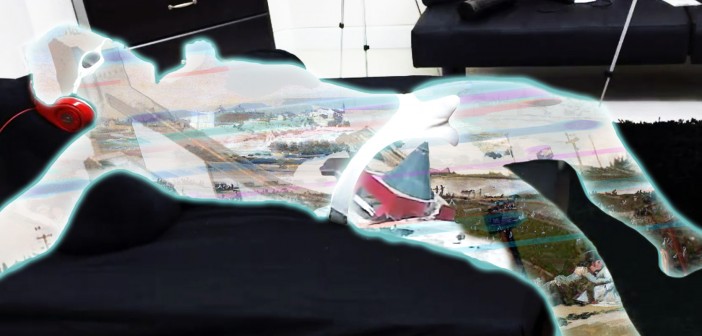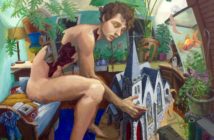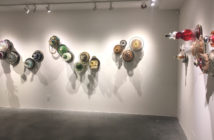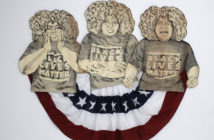This interview is part of the “Boston Common” series that seeks to highlight the people and institutions that shape Boston and New England’s vibrant art community. In this installment, we spoke to Dylan Hurwitz, an artist who serves as director of The Boston LGBTQIA Artist Alliance (BLAA).
What is the Boston LGBTQIA Artist Alliance (BLAA)’s mission? How do you serve the city and the surrounding communities?
BLAA is an artist-run volunteer organization that is dedicated to elevating the voices of and providing resources to Boston area LGBTQIA-identifying artists. We focus primarily on exhibition opportunities, though we also host other events such as workshops, artist talks, potlucks, performances and other creative social outlets.
Our exhibitions are organized via open calls- and we do not view these simply as one-off events. We don’t want to just give artists a show- ideally those who participate in our shows meet a new friend; start following a new artist’s work; or join the BLAA Committee, and through this have a say on the future endeavors of the organization.
I want to make a distinction, I do not see myself as representing a community; I see myself leading an organization whose goal is to provide a platform for Boston area LGBTQIA identifying individuals to represent themselves; to share their visions and their stories.
Will you talk about your background and how you became involved the BLAA?
I’m originally from the Philadelphia area, from what is basically a river town version of Provincetown- New Hope, Pennsylvania. I grew up in an artistic family and studied both piano and painting from Kindergarten onwards. My mother is a painter and I owe my current pursuit of art in large part to the example she set and her encouragement through the years. In high school, I became involved in activism. I joined my high school’s Amnesty International group, and started an Environmental Club/Recycling Program with some friends. This early activism, along with my upbringing laid the foundation for much of what I did throughout my college years and up to now.
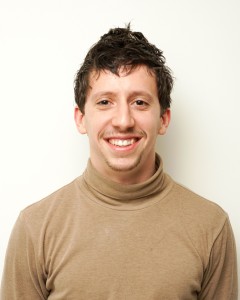
Dylan Hurwitz.
I attended Hampshire College for two years and studied classical piano performance and painting. I eventually decided to transfer to art school and attended the SMFA/Tufts, graduating in 2013. Throughout my undergrad I interned and worked at various arts organizations and galleries, including Fort Point Arts Community for over two years. More recently I worked as Project Coordinator for the City of Boston’s cultural planning process, Boston Creates, through its community engagement phase.
As any art school graduate can likely relate, the challenge post-undergrad is taking stock and figuring out how one can realistically and sustainably establish one’s studio practice- and figuring out the work/art balance. It becomes clear quickly how important it is to actively build and be a part of some sort of arts community, whatever that means to you.
I started attending BLAA Committee meetings to build and/or be part of some sort of arts community. This was shortly before the previous director Sean Johnson stepped down in late 2014.
The organization’s future looked uncertain for a period- but after expressing my interest in stepping up as director, I worked with previous committee members Alex Mancini and Allison Rodriguez, as well as Coorain Devin to re-launch programming in 2015. Fast forward to now, and we have our first two shows under our belts since the relaunch, upcoming programing already planned, and expanded committee that includes artists from some of our recent shows (including Tom Maio, Lenny Schnier, Geena Matuson, Joshua Davis, Amir Dixon, Jamezie, and Giancarlo Corbacho).

Giancarlo Corbacho & Ariele Max. From Post-Gay? Photo courtesy of BLAA.
What have been the organization’s most significant achievements since you’ve become involved? What challenges do you face looking ahead?
I think our most significant achievements are our first two shows, Makeover! And Post-Gay? and the roughly 40 artists we’ve been able to work with and bring together in a short amount of time- some of whom are now on the BLAA Committee working on upcoming programming.
I’m grateful for the number of artists who have shared their work, and those we have been able to work with and hopefully introduce to one another. The response to our shows has been really encouraging and affirming- it feels that we are addressing a need in the city- a space to highlight the work and the conversations being had by Boston area LGBTQIA identifying artists.
We have been lucky to have the support of other organizations since BLAA’s over the years- the AIDS Action Committee, Fenway Health, the MALE Center, and more recently Connected Boston/ the Multicultural AIDS Coalition. We want to continue building relationships with other organizations as we grow our programming.
Our biggest challenge right now is that we lack a physical home base for the organization. Previously, we had access to a storefront gallery space in the South End where most programming/exhibitions were held. That space no longer exists as of late 2014, just as I joined the group. Space is hard to come by, and we have no budget for rent as a small organization, so we’ve worked with Boston area galleries to stage our shows. It can be tricky securing locations for our shows, but Boston galleries have been very supportive of and receptive to the work we are doing.
While I would not use the word “challenge” to describe it, I would say that something I am focused on as we make decisions regarding our programming (and BLAA as an organization) is inclusivity and representation. While society at large has made progress in regards to LGBT rights, too often it has come at the expense of those who are more marginalized- i.e. those in the LGBTQIA community who are not white, male or cisgendered. As an organization we want to be cognizant of this and work to elevate these voices and doing this involves an active commitment to reaching out, to listening to others. These are things that we don’t think about once and then put away; these are ideas we must constantly unpack and discuss in an ongoing manner.
What’s the BLAA’s main project now? How will you complete this project?
In the immediate sense, BLAA’s main project is our upcoming exhibition, Post-Gay? which opens at the Distillery Gallery this Friday, March 18, 7-9pm. The show runs through April 16, 2016 and features 20 artists (Robert Chamberlin, Daniel Corral, Dave J Bermingham, DEAD ART STAR, Giancarlo Corbacho+Ariele Max, Jamieson Edson, Jeremy Endo, Gordon Feng, David Hannon, I.B.E., Jamezie, Liss LaFleur, Christopher Lineberry, Kirk Lorenzo, Dino Rowan, Hogan Seidel, Randi Shandroski, Warith Taha, Sarah Washburn, Zoe Perry-Wood) who are doing and undoing their own ideas of self and desire.
In general, BLAA remains focused on our core programming- our three open calls/exhibitions each year. We have plans to launch new programming, including an art crit series as well as studio visits, but our priority is to put on well thought-out shows and programs.
The call for our summer exhibition is coming out shortly, which is a show where we hope to highlight Boston area LGBTQIA artists working at the intersection of the following identifiers: “queer”, “artist” and “disabled.”
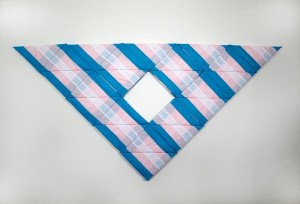
Jamezie. From Post-Gay? Photo courtesy of the BLAA.
An ongoing project is building up the BLAA Committee, which meets once a month and plans our exhibitions and other events. If anyone reading is interested in joining, please email boslgbtqiaarts@gmail.com to get involved!
Will you discuss your current work and process? How does the Boston community influence your practice?
My studio practice is based out of the Distillery building currently, but I am relocating to a studio at the Brewery in Jamaica Plain, a few blocks from my apartment. I can’t wait. I currently wake up at 5am and get to the studio by 6am to paint before work at 10am, so having my studio closer will be very helpful.
I work primarily with oils, but incorporate elements of photography, printmaking, drawing and performance in my practice. My background as a musician has an ongoing impact on my work- I studied classical piano from Kindergarten through college. In general terms, I often gravitate towards music for its immediacy, and it is something that I seek in my painting practice- whatever that might mean, or however that manifests. I often think of my paintings as performances.
I’ve recently thought a lot about how my work with BLAA and with organizing relates to my studio practice and see myself pursuing projects that address this in the near future.
How does your own work as an artist and curator support your role as director of the BLAA?
My work as an artist supports my role as director of BLAA and vice versa- being an artist-director gives me the perspective that a non-artist director would lack. Being an artist motivates me in many ways- I understand the importance of (free) exhibition opportunities and the chance to connect to a larger community, and this drives the work I do as BLAA’s director. Meeting other artists and bringing others together around art is one of my favorite things about working with BLAA.
Finally, will you name one Boston-based organization that exceeded your expectations in 2015, and tell us why?
Isles Arts Initiative was an amazing feat this past summer- and I would love to see more grass-roots initiatives like this take root and be encouraged in the city.

